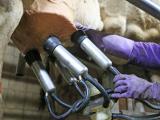Feb 13, 2012
CDC: Flu off to latest start since 1988
The US Centers for Disease Control and Prevention (CDC) said recently that the current flu season is off to its latest start since the 1987-88 season. The CDC said the mark it uses to signify the start of the flu season, when the percentage of respiratory specimens testing positive for flu exceeds 10%, was reached for the first time this season during the week ending Feb 4. Over the past 29 years, the percentage stayed below that level until February only once before. In its Feb 10 update, the CDC noted increases in other flu indicators, including flulike activity above baselines in two regions, and the first state—California—reporting widespread geographic activity. Lyn Finelli, DrPH, chief of domestic surveillance for the CDC's influenza division, said in the statement that increases in positive respiratory samples should forecast increases in other indicators in the weeks ahead. The CDC urged people who haven't been vaccinated to be immunized now, and pointed out that it takes 2 weeks for the body's immune system to mount a defense against flu after vaccination. It added that the timing of flu season is unpredictable, which can begin as early as October and end as late as May.
Feb 10 CDC "Have You Heard?" statement
Flu scare sparks temporary quarantine of plane in New Zealand
Health officials in New Zealand acknowledged that they overreacted when they kept a planeload of Japanese students waiting for about 3 hours on the Auckland airport tarmac today while they were examined for possible influenza, according to an Agence France-Presse (AFP) report. The Air New Zealand flight from Tokyo was detained after the airline told authorities that about 60 passengers were showing flu-like symptoms. The local health department sent medical teams in biohazard suits on board to examine the students. Officials eventually allowed them to leave the plane after determining that, though some had colds, they had received flu vaccinations and did not have a flu virus. "In hindsight we overreacted to this but that's better than underreacting. We needed to make it safe until we were sure," Richard Hoskins of the Auckland Regional Public Health Service told AFP. The story said Stuart Cundy, head of the organization hosting the students, was puzzled at the fuss over his visitors. "I've been travelling with them for an hour-and-a-half on a bus and I haven't heard a sneeze," he told the New Zealand Herald.
Feb 13 AFP story
More H5N1 in Vietnam, Hong Kong, and Nepal
Vietnam's agriculture ministry announced that the H5N1 avian influenza virus has struck backyard poultry in two more provinces, according to a Feb 10 report to the World Organization for Animal Health (OIE). The outbreaks occurred in villages in Ha Nam, in northern Vietnam, and Hai Duong, in northern Vietnam's Red River delta. The two outbreaks killed 3,000 birds, and 3,037 more were culled to curb the spread of the virus.
Feb 10 OIE report
In other developments, Hong Kong officials today said the H5N1 virus has been confirmed in two more wild birds, little egrets that were found dead near the entrance of Tuen Mun Park on Feb 6 and 7, according to a press release from the Agriculture, Fisheries, and Conservation Department (AFCD). The birds are commonly found in Hong Kong. The AFCD said it would continue to inspect poultry farms to ensure avian influenza precautions are being observed, and it warned people to avoid personal contact with and clean their hands after handling wild birds and live poultry.
Feb 13 AFCD press release
Elsewhere, authorities in Nepal have confirmed H5N1 at poultry farms at three sites in the country's Jhapa district, located in eastern Nepal, the Himalayan Times, a newspaper based in Kathmandu, reported yesterday. The virus was confirmed by the Central Animal Disease Research Laboratory in Kathmandu from samples from dead poultry collected some time ago, according to the report. District officials have declared the areas "crisis zones," and culling activities will begin soon. H5N1 outbreaks were recently reported in Sunsari and Ilam districts.
Feb 12 Himalayan Times story
Raw milk Campylobacter outbreak grows to 65 cases
The number of Campylobacter illnesses linked to raw milk sold by a Pennsylvania dairy has grown to 65, according to an e-mail update today from the Pennsylvania Department of Health (PDH). The total is 5 more than the PDH reported Feb 10. Of the cases, 56 are from Pennsylvania, 4 from Maryland, 3 from West Virginia, and 2 from New Jersey. raw milk from The Family Cow store in Chambersburg has tested positive for the outbreak strain, but last week the Pennsylvania Department of Agriculture cleared the operation to resume production of unpasteurized milk.
Feb 7 CIDRAP News Scan "Five more sickened in raw milk Campylobacter outbreak"
Hand, foot, and mouth disease reported in Alabama
Some Alabama counties are facing an outbreak of hand, foot, and mouth disease (HFMD) caused by a virus strain not yet seen in the United States this year, according to a story from the Andalusia Star-News of Covington County. A pediatrician in Opp in Covington County said he has seen several cases, two of which were confirmed by the CDC. Bhagwan Bang, MD, said the unusual strain, coxsackie A6, has caused more extensive and larger lesions compared with other strains, as well as cases in adults. HFMD typically affects children younger than 5. "It usually starts with a fever, poor appetite, malaise and sore throat, painful sores in the mouth, on the palms of hands and soles of feet," Bang said of the outbreak strain. "It also appears on the knees, elbows and buttocks, and can also cause dehydration due to the inability to swallow fluid." He stressed hand washing and other hygiene measures to curb disease spread.
Feb 10 Andalusia Star-News story





















